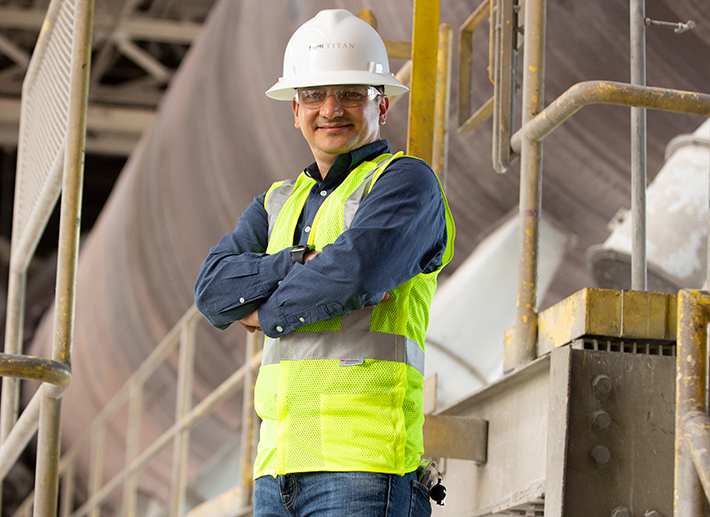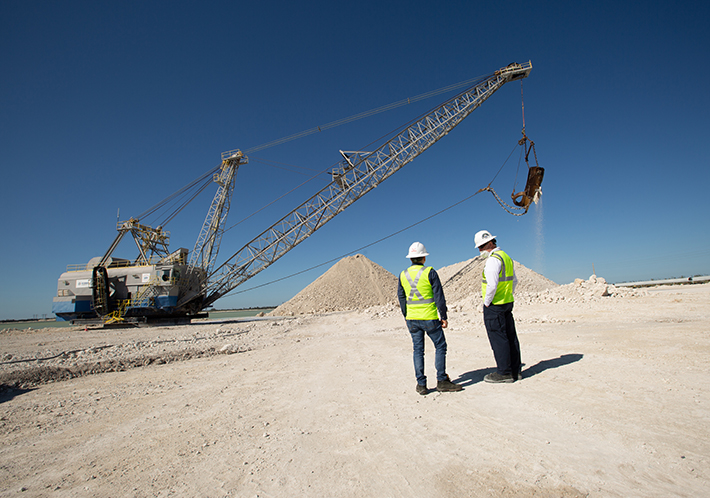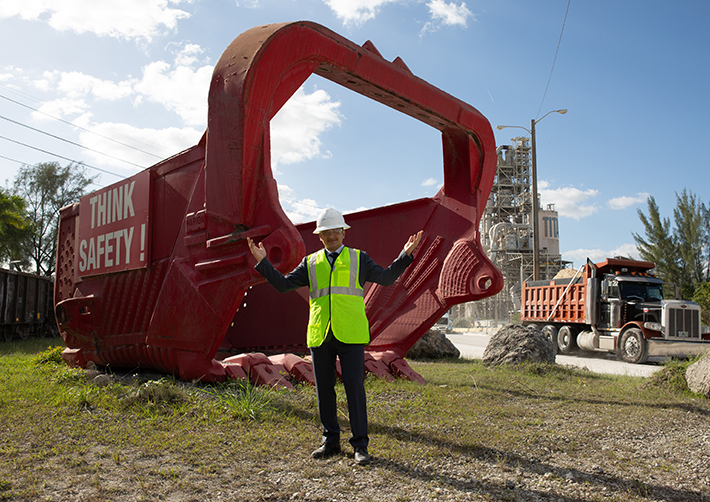
Concrete Leadership
Many of us take concrete for granted. As the material that often makes up the very buildings around us, it is easy to go through a given day without giving this material — and the cement used to create it — much thought. However, as a civil engineer, Cesar A. Constantino, Ph.D., ASTM International’s 2022 board chair, sees concrete as a game-changing material that can transform economies and societies.
“My involvement with cement and concrete goes back to my college education. I learned how concrete can be the game changer when it comes to buildings; when it comes to bridges; when it comes to dams; when it comes to basically everything around us,” he says. And with an M.S. degree in structural engineering and a Ph.D. degree in construction materials to go with his B.S. in civil engineering — all from the University of Texas at Austin — Constantino has seen a great deal of building in his time.
![]() As director of business development for Separation Technologies LLC, a Titan America business, Constantino lends his expertise to the leading producer of processed fly ash in the United States. An ASTM member since 2005, he works on the committees on cement (C01); concrete and concrete aggregates (C09); and sustainability (E60). He has also made key contributions to the ASTM Memorandum of Understanding Program in Latin America.
As director of business development for Separation Technologies LLC, a Titan America business, Constantino lends his expertise to the leading producer of processed fly ash in the United States. An ASTM member since 2005, he works on the committees on cement (C01); concrete and concrete aggregates (C09); and sustainability (E60). He has also made key contributions to the ASTM Memorandum of Understanding Program in Latin America.
FOR YOU: The Shape of Concrete to Come
Before joining the Titan staff in 2005 as a manager of technical services, Constantino worked as a researcher and a consultant both in Panama and the United States. He then took on the role of director of concrete technology for Titan America LLC from 2007 to 2011, followed by the roles of senior director of process quality and then vice president of corporate engineering for Titan before assuming his current position.
Q. Tell us about your work with Titan America and how you first became involved in the concrete and cement industries.
A. My education as a civil engineer inspired me to build infrastructure, to develop superstructure. I definitely pursued a career that involved deeper learning, so I was educated in the areas of structural engineering and then ultimately construction materials, particularly concrete. I think cement and concrete are pillars of development globally. And when you bring together the safety of a home, when you bring together a society because of the bridges that connect it, when you bring resources to a society to blossom, all because of infrastructure, cement and concrete are the foundation.
This has been a very rewarding career. I have had the opportunity to interact with students now, the younger generation coming together and carrying the torch of construction and learning about concrete. So I engage with students as well as with engineers and with users of concrete. And you can actually see the future, it’s there, for us to use construction materials for a safer society.

Q. Globally, there is an emerging need for sustainable construction as the world moves towards a net zero, circular economy. How is Titan America becoming more sustainable, and how have standards guided this process?
A. At Titan America, our top priority is to reduce the carbon footprint of all of our operations. Similarly, we engage with industry to drive the entire sector towards a more sustainable future. As part of this transition, our industry, and particularly Titan, is looking at aligning activities towards meeting the United Nations Sustainable Development Goals.
An example of the successes we have had include facilities like the one in Medley, Florida, where we're taking waste product and converting it into alternative fuels to replace the traditional use of fossil fuels such as coal in our operations. This directly impacts and benefits lowering that CO2 footprint. And we have used ASTM along this journey. ASTM International standards have paved the way for transitioning products, where for example, we can take a type of cement and transition to a much lower environmental footprint material using ASTM standards such as C1157, which is a performance-based standard for hydraulic cement.
The availability of standards, in general, facilitates the steps that increase the speed at which sustainable attributes can actually be brought to the market. So leveraging the value of standards has facilitated and shortened the time it would normally take to bring new technology to fruition. Once standardized, methods get adopted, and they become the standard again for future activities.
Q. The construction industry has seen major technological advances in recent years, particularly in the areas of concrete and cement. What changes have you seen and what does the future look like for your field?
A. The future is bright. We have existing talent that is engaged with the cement and concrete industries to take advantage of new products, to take advantage of new process techniques, and to take advantage of Industry 4.0 concepts, which involve anything from big data to artificial intelligence models that can make processes more efficient.
Over the last few decades, one of the traditional mindsets was that cement and concrete would evolve very slowly, in part because we are looking at safety, and we want to make sure that built structures last for many years. And so there is always a healthy debate in terms of incorporating changes to traditional approaches and standards.
However, supplementary and alternative cementitious materials that have not been part of the solution in the construction sector in the past are now being used with newly created standards and are becoming part of our palette of options when it comes to being more sustainable. So from fly ash to slag to natural pozzolans and a number of other materials — these are combining to deliver a smaller environmental footprint.
Another way things have evolved over time is with the principle of a circular economy. At Separation Technologies, we take what would otherwise be deemed a waste product from coal power generation after the coal is burned, and we reuse it. Ash, the residue of coal burning, would traditionally be landfilled, but we actually take that material and process it, and then put it back into the cement and concrete sector. That creates a true circular economy cycle, where material is no longer taking space in landfills but is actually helping us save on the manufacturing of new product that would require virgin mining.
Q. What has being part of ASTM International meant to your career? What would you tell younger professionals if asked about the benefits of becoming a member?
A. ASTM has been a door-opener. ASTM has been like a university, post university. ASTM committees, meetings, and work groups connect with the world, experts, and all of the people who are engaged to develop and help make the world better by standardizing processes or test methods.
For me, if I ever wanted to look at the success of the development of new technologies or the success of creating safe protocols for different materials, that's where ASTM would be the door-opener. It would connect me with those subject experts. It would facilitate dialogue and exchange, and you would continue in a learning environment all throughout the development of standards. So for me, I would invite the younger generation to join the committees because they are where you will continue to gain exposure to new concepts. Again, engage with experts and you will be able to not only learn, but then pass the torch on to future generations in turn. So it's a continuous education approach that allows us to, again, help the world work better.
I'm also a firm believer that ASTM’s chapters will be part of its success. We already have a chapter in the United Arab Emirates where there's a boom and potential growth. We also have student chapters that are now also serving as seeds to provide more opportunities for the younger generation.
One of these chapters is actually in Peru, and we have another one at Florida International University. I envision that the presence of these chapters throughout the world will engage communities to adopt standards that will help developing economies harmonize the way in which construction happens. And cement and concrete ultimately connect the dots, as they say.
Q. You’ve been with ASTM International for more than 15 years. How have you seen the organization grow and change during your time?
A. Over the last 15 years, ASTM international has effected significant change in creating international participation. Over 140 countries now have some engagement with ASTM, and coming from Panama in Central America, I have been able to network globally.
READ MORE: Green Building with Hempcrete
Participation through committee work, even if it's not in person, but through software platforms that allow the community to collaborate in the standard development process, is something that's done very easily today. The standards being created have global application. So a standard can be used in Vietnam just as it can be used in the United States, which is an important piece. Another is that within ASTM, we have a completely open, completely transparent way of conducting business. The opportunity is there to invite all committee members to bring forward their ideas and create a better world.
One of the opportunities that lies ahead is to continue to build on the outreach programs that have taken place over the last few years through the various memorandums of understanding that have been signed with over a hundred countries globally. And in particular, these are going to be key as part of the United States-Mexico-Canada Trade Agreement (USMCA). There is going to be an opportunity for standards to cross borders and facilitate not only trade but the adoption of improved practices. The fields of health and amusement parks, for example, are two areas in which ASTM standards are already being used in Mexico for the purposes of improving and enhancing the experience and ultimately the safety of users.

Q. ASTM has been making strides with diversity, equity, and inclusion (DE&I). What does DE&I mean to you and how do you believe DE&I efforts will enhance ASTM's voluntary consensus approach to standards development?
A. DE&I is a very personal take for each individual, and I look at DE&I as a synonym for success.
I think when you have diversity of thought, you give everybody the opportunity to participate, and when you include people from all the pools that you have access to — which in the case of ASTM International is the whole world — you come out better.
DE&I is something that ASTM has included in their committee activities, where we have a balance of producers, users, and general interests trying to maintain that all the stakeholders are not only represented, but that they are active and participating. This is true whether it's in the standards development process, or the day-to-day office work and interaction between peer groups, with stakeholders.
DE&I very personally means the equivalent of success. The more we embrace it, the more we let it grow, the more success for human society.
 SN Home
SN Home Archive
Archive Advertisers
Advertisers Masthead
Masthead RateCard
RateCard Subscribe
Subscribe Email Editor
Email Editor